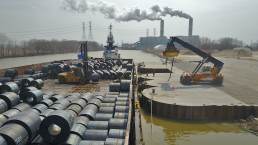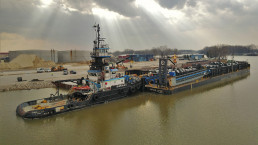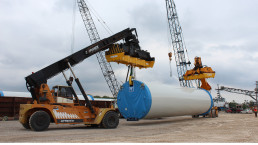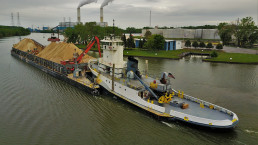Peters Tours of Port of Monroe with Acting CBP Commissioner and Port Leaders
MONROE, MI – U.S. Senator Gary Peters (MI), Chairman of the Homeland Security and Governmental Affairs Committee, today toured the Port of Monroe with Customs and Border Protection (CBP) officials, including Acting Commissioner Troy Miller, and Port of Monroe leaders to assess current operations and discuss resolving ongoing cargo clearance challenges the port faces. In recent years, the Port of Monroe has been restricted by CBP’s Detroit Field Office from accepting international break bulk cargo and prohibited the port from accepting international maritime containers, unless the port invested in significant and costly screening technology and infrastructure upgrades. Other Great Lakes ports have reported not being subjected to the same restrictions, which undermines Michigan’s economic competitiveness. As Chairman of the Committee that oversees CBP, Peters has long pressed CBP for answers on why there are these unequal requirements, and advocated for the Port of Monroe to be held to the same standards as other ports in the region.
“I appreciated today’s opportunity to show Acting Commissioner Miller and other Customs and Border Protection officials how the Port of Monroe is working to deliver critical products to families and businesses across Michigan and the Great Lakes region. We were able to see firsthand how Director Paul LaMarre and his leadership team are investing in stronger security screening and infrastructure so they can expand operations,” said Senator Peters. “Acting Commissioner Miller and I discussed how we can work together to resolve longstanding issues, that limit Michigan’s economic competitiveness and raise questions about whether these screening rules are truly effective and based on risk. We also discussed the economic engine of the Great Lakes and how expanded cargo services could increase economic activity for the region and the nation. I’ll continue fighting to ensure Michigan’s ports are treated fairly and have the resources necessary to ensure our state can continue to serve as a hub for international commerce.”
“The unrelenting advocacy of Senator Peters and the support of his legislative team has served as the fuel propelling the Port of Monroe to reach its potential as Michigan’s first maritime container terminal. The Senator’s deckplates leadership has never been more apparent than during this visit,” said Paul LaMarre, Director of the Port of Monroe. “Acting Commissioner Miller’s presence in our community and footsteps upon our dock represent USCBP’s commitment to ensure that the Port of Monroe, and all Michigan Ports, will be open for business as we strive to sustain the ‘Great Lakes State’s’ economic vitality during this challenging time. Following this meeting it is imperative that Michigan’s CBP leadership finds ways to ensure that Michigan’s Ports receive equitable allocations of personnel, tools, and technology as Senator Peters’ has continually legislated for their enhanced resources.”
During the visit Peters, Miller and other CBP officials met with the Port of Monroe’s leadership team to discuss the ongoing challenges and what additional resources are required to ensure that incoming cargo is safe and secure, assure reliable and consistent service, boost operations, and expand their capabilities to provide increased cargo services throughout the Great Lakes region. They also toured the Port’s existing facilities and discussed planned upgrades to ensure the Port can handle additional types of cargo.
In his role on the Homeland Security and Governmental Affairs Committee, Peters has fought to support Michigan’s ports, especially the Port of Monroe, and ensure they receive fair treatment. He recently announced the Port of Monroe received a federal grant to help upgrade cargo screening infrastructure. A bipartisan measure coauthored by Peters was signed into law requiring federal officials to assess all ports of entry, including finding ways to reduce wait times for passengers and cargo at the border. Peters has repeatedly pressed CBP on why the Port of Monroe is being held to standards that are not applied to other ports in the region. Peters recently published an op-ed, outlining the importance of making sure Michigan’s economic competitiveness is not being undercut by unfair policies or practices. Peters also helped secure a $1.1 million federal grant for the Port of Monroe to expand its maritime commerce operations. In 2019, Peters authored legislation to authorize CBP to hire 600 additional CBP Officers each year until needs identified in the workload staffing model are met.
###
Peters Announces Port of Monroe Awarded $770,983 Grant to Help Upgrade Cargo Screening Infrastructure
WASHINGTON, D.C. – U.S. Senator Gary Peters (MI), Chairman of the Homeland Security and Governmental Affairs Committee, today announced the Port of Monroe has been awarded a $770,983 Port Security Grant from the Department of Homeland Security to help upgrade their cargo screening infrastructure. The funding will allow the port to install a Radiation Portal Monitor, which helps to screen cargo for the presence of nuclear or radiological materials. This will enhance the port’s ability to ensure that incoming cargo is safe and secure, boost operations, and could expand their capabilities to provide increased cargo service throughout the Great Lakes region.
“Congratulations to Director Paul LaMarre and the Port of Monroe on receiving this vital funding. The Port of Monroe serves as an indispensable resource to manufacturers in Michigan and across the Great Lakes region. This critical investment will help the port grow and deliver the products that businesses and families rely on each day,” said Senator Peters. “This funding, which will help the Port of Monroe ensure shipments are safe and secure, is an important step to aid their efforts to expand, begin accepting additional types of cargo, and support jobs and grow the economy in Southeast Michigan. I’ll continue fighting to put Michigan ports on a level playing field so we can ensure our state remains a hub for international commerce.”
“The receipt of this critical grant funding confirms that the Department of Homeland Security, U.S. Coast Guard, and FEMA are aligned and supportive to promote the safe, efficient, and secure movement of containerized cargo through the Port of Monroe. Senator Peters’ unrelenting fight to ensure the Port’s continued growth and economic importance to our region has never been more evident,” said Paul LaMarre, Director of the Port of Monroe. “As Senate Homeland Security Chairman, Senator Peters is ensuring that vital security funding is making it home to Michigan in support of expanded economic opportunities. This grant places the Port of Monroe in full compliance with the SAFE Port Act and in turn, should allow U.S. Customs and Border Patrol to fulfill their mission of enhancing our nation’s economic prosperity.”
In his role on the Homeland Security and Governmental Affairs Committee, Peters has supported funding for the Port Security Grant Program and has fought to support Michigan’s ports, especially the Port of Monroe, and ensure they receive fair treatment. A bipartisan measure coauthored by Peters was signed into law requiring federal officials to assess all ports of entry, including finding ways to reduce wait times for passengers and cargo at the border. Peters also repeatedly pressed U.S. Customs and Border Protection on why the Port of Monroe is being held to standards that are not applied to other ports in the region. Peters also recently published an op-ed, outlining the importance of making sure the economic competitiveness of Michigan and other Great Lakes states is not being undercut by unfair policies or practices. Peters also helped secure a $1.1 million federal grant for the Port of Monroe to expand its maritime commerce
operations.
###
Port of Monroe earns another award
The local port has once again received the Robert J. Lewis Pacesetter Award, a recognition given to domestic shipping industry leaders by the St. Lawrence Seaway Development Corp.
Regulations and shifting industry demands haven’t turned the tide against the Port of Monroe.
The local port has once again received the Robert J. Lewis Pacesetter Award, a recognition given to domestic shipping industry leaders by the St. Lawrence Seaway Development Corp.
The award was for 2019 shipping season, which saw some of the port’s most diverse cargo handlings, said director Paul LaMarre III.
“To be one of the ports to receive this award. I feel an immense sense of pride ...” LaMarre said. “I am proud of the relationships we have built, the vessels that have touched our dock ... and the men and women who breathe life into our facility.”
The Pacesetter is given to American ports along the St. Lawrence Seaway that increase their international tonnage compared to the previous year.
This is the fifth time in seven years that the port has received the award. It also was recognized for its 2013, 2015, 2017 and 2018 shipping seasons.
The streak shows how far the port has come in recent years, according to LaMarre. He has led efforts to attract more international business since he came to the port in 2012.
Before then, the port had not handled international cargo since the 1960s, he said. He credits the growth to partnerships with Spliethoff and Big Lift, international shipping businesses, and the work of its terminal operator, DRM Terminal Services.
“In 2012, the Port of Monroe was an overgrown industrial site,” LaMarre said. “Today, it is one of the most prosperous seaports on the Great Lakes.”
The 2019 shipping season was the most active for the port when it came to handling international vessels, according to LaMarre.
What was most notable about it was the port’s reach, including routes that touched Egypt, the Netherlands, Peru and Canada, he added.
The last season saw the Happy Ranger call on the port to deliver a new stator to Fermi 2 nuclear power plant, boasting one of the heaviest and most valuable shipments to travel the seaway, LaMarre said.
After the Happy Ranger delivered the stator from the Netherlands, it then turned around and loaded wind tower segments from Ventower, which were delivered to Peru.
“It was sheer logistics perfection ... it extended our community’s reach on a global scale,” LaMarre said. “It’s proof positive that our port and its partners are making our mark on global logistics.”
Other international vessels handled liquid asphalt and salt, which accounted for the largest increase in tonnage.
“You can move countless specialized components, but nothing equals the volume of bulk cargo and the tonnage that generates,” LaMarre said.
The other ports to receive the designation are the Port of Chicago; the Duluth Seaway Port Authority in Minnesota; the Port of Green Bay, Wisconsin, and the Port of Oswego Authority, New York.
SLSDC’s Deputy Administrator Craig Middlebrook congratulated this year’s award recipients in a press statement.
“The dedicated team of professionals at our ports work hard to move increasing amounts of cargo safely and efficiently,” he said.
Despite a slow start to the shipping season because of the impact of COVID-19, LaMarre said the port is on track to receive the award again next year.
“The award is a testament to our growth and resilience,” LaMarre said. “We have had countless challenges — it is the resilience of the port’s team ... that made this possible.”
Port welcomes largest project in history
Source: The Monroe News
The port will be called on 14 times for the project, handling about 560 wind tower segments in total.
Wind energy components are breezing through ports across the Great Lakes this shipping season.
The trend is benefiting the Port of Monroe, which is in the midst of handling one of its largest cargo endeavors.
A partnership between the port, Monroe-based Ventower Industries — a company that specializes in fabricating wind turbine towers — and Spliethoff Group’s BigLift Shipping is supporting General Electric’s wind energy efforts in the state.
Every eight days, the port handles a shipment of forty wind tower segments, according to Port Director Paul LaMarre III.
“The port has come a long way,” LaMarre said. “We have become a congregation and distribution hub for wind tower segments … It is the largest project in our history.”
The shipments, which take off from Becancour, Quebec, traverse the St. Lawrence Sea, the 2,300-mile marine highway that connects the Atlantic Ocean to the Great Lakes. They are being handled by the M/V Happy River, a BigLift ship.
The port will be called on 14 times for the project, handling about 560 wind tower segments in total.
“It comes down to relationships,” LaMarre said. “If you build relationships, the cargo will come.”
General Electric has a partnership with Ventower, which has produced several wind energy components for the company, according to LaMarre. Ventower has long used the port to move its products, he added.
That relationship drew the attention of General Electric, which saw the port’s logistics capabilities as advantageous, LaMarre said.
“At a time when other great lakes port are struggling to find any cargo, the relationships and business the port has built will ultimately provide to our sustainability,” he said.
The project is particularly important to the port due to a slow start to the shipping season, which usually begins in March.
COVID-19 had an impact on the port, LaMarre said, adding that cargo was scarce during the early days of the pandemic.
Limestone and coal account for a large part of the port’s business. There was less of a demand for the two as heavy industry and businesses were closed or restricted in an effort to slow the spread of the virus.
DTE Energy’s Monroe Power Plant also was impacted, LaMarre said. The utility generates a lot of business for the port, he added.
“When industry is nonoperational, little electricity is being used,” LaMarre said. “Humanity by itself doesn’t place place as much demand on the electrical grid as heavy industry does.”
For the first two months of the season, the port had no cargo to handle. It started receiving shipments in early May and coal shipments to the power plant have returned to a near-weekly basis, according to LaMarre.
The size and weight of the wind tower segments will help keep the port on track to beat its tonnage from last season, LaMarre said. Last month the port received a Pacesetter Award, which is given to ports that annually increase their handling of international shipping tonnage.
The pandemic also has changed operations at the port, which is taking extra precautions, LaMarre said. No COVID cases have been reported to the agency, he added.
All workers wear masks when on the dock. Port workers also stay on the dock when handling cargo while workers on vessels remain on their ships.
“It’s been challenging, to say the least,” LaMarre said. ”… we continue to count our blessings every day. Without this project this year, we would be facing significant challenges.”
St. Lawrence Seaway active with international shipments, moving global supply chain
American ports in the Great Lakes-St. Lawrence Seaway system record particularly noteworthy increases in project cargo as they advance the global supply chain, trading with 22 countries during the first two months of the navigation season. Year-to-date total tonnage—from the opening of the St. Lawrence Seaway on April 1, 2020 through May 31, 2020—is situated at 7.7 million metric tons (mt), down 10.2 percent compared to this time last year.
“In times like these, it is reassuring to see our ports in the Great Lakes St. Lawrence Seaway System working hard to keep the supply chain moving. The Great Lakes Seaway marine transportation system is critical infrastructure, and remains vital to keeping commerce flowing without disruption in order to support North America’s agricultural, manufacturing, construction, energy, and mining industries,” said Craig H. Middlebrook, Deputy Administrator of the U.S. Saint Lawrence Seaway Development Corporation.
Wind Energy Components Soaring at American Great Lakes Ports
With an increased focus on commodity diversification through project cargo, international shipments of wind energy components in the Great Lakes region are taking off. During the first two months of the 2020 navigation season, shiploads of wind-related components were handled across five Great Lakes states at eight American ports, including: Port of Monroe, Port of Erie, Port of Buffalo, Port of Ogdensburg, Port of Bay City, Port of Menominee, Port of Indiana-Burns Harbor and Port of Chicago.
Attracting new business through wind-related cargos and Seaway activity, both Port of Monroe and Port of Buffalo are benefiting from notable increases in shipping traffic.
“If there was a single word to describe the Port of Monroe, it would be resilient,” said Paul C. LaMarre III, Port Director, Port of Monroe. “Everything we have done puts relationships and the broader industry as a whole first. I believe, if you build the relationships, the cargo will follow it.”
Of these relationships, this navigation season brings to light a particularly impactful partnership between the Port of Monroe, Spliethoff Group’s BigLift Shipping, and Ventower Industry—one of four wind tower manufacturers in the United States—all working together to move, handle and manufacture wind towers for a General Electric project based in Michigan.
The Port of Monroe, serving the project as an advantageous congregation point for high value wind components coming by rail and vessel, now welcomes BigLift’s M/V Happy River on a nonstop shuttle delivering wind tower sections manufactured in Bécancour, Quebec every eight days.
In addition to logistical advantages due to the Port’s geographical location, BigLift’s vessels are particularly well suited for the Port of Monroe due to their size and the Port’s draft restrictions. To date, the M/V Happy River completed three voyages to Monroe—with eleven more planned—carrying forty wind tower sections per trip.
“The wind project and the tower sections are the lifeblood of our port this season,” said LaMarre. “Not only is this project impactful from the number of vessel calls, which will be the highest in our history for Seaway cargo, it’s with a partner that we’ve been in the trenches with for five years, has the majority of the Port’s laydown area being utilized, is using multiple modes of transportation, and sustaining our port workforce and partners in challenging times.”
Similarly, the Port of Buffalo is off to a strong start, filling their docks a total of thirty-two days since their navigation season began on April 12, 2020. To date, the Port of Buffalo welcomed three Seaway shipments of wind turbine components—two from Germany and one from Korea—and are expecting two more in the coming week.
“To the Port of Buffalo, handling these wind turbines means a full dock for the season. Not only are we unloading the vessels, but we’re also loading the trucks that take them to site. So, this is an opportunity to keep us busy all the way into fall,” said Patricia C. Schreiber, Port Director, Port of Buffalo.
Seaway ports see cargo volumes set for rebound
Source: MarineLog
While St. Lawrence Seaway cargo volumes decreased during the past two months due to economic shifts related to COVID-19, the Chamber of Marine Commerce reports industry leaders as saying that the Seaway is ready to play its part in the economic recovery efforts in the coming months.
Overall, St. Lawrence Seaway tonnage from March 15 through May 31 totaled 7.7 million metric tons, down 10% compared to the same time period in 2019. Road salt and project cargo shipments such as wind turbine components have remained strong throughout the last two months. However, cargo volumes of steel-related materials, construction materials, and petroleum declined.
“Great Lakes-Seaway shipping has continued to get the job done during these challenging times, safely delivering vital grain, renewable energy supplies and manufacturing inputs for domestic needs and world markets,” says Bruce Burrows, president of the Chamber of Marine Commerce. “Ship operators, ports, suppliers and the Seaway operators have really pulled together to put protective measures in place for our workers and the public and to ensure our transportation system has continued to operate throughout the pandemic without interruption or delay for our customers. Moving forward, Great Lakes-St. Lawrence Seaway shipping is ready to support ongoing efforts to restart the U.S. economy.”
DRY BULK DOWN, GENERAL CARGO UP
Dry bulk cargo shipments on the Seaway were down 5%. However, one of the first areas of improvement expected in cargo volumes are construction materials as pandemic-related restrictions continue to be lifted.
Year-to-date general cargo shipments via the St. Lawrence Seaway, including project cargo like wind turbine components and aluminum, were up 3.5%.
The Ports of Indiana-Burns Harbor has received 15 shipments of wind turbine components over the last two months. “We expect at least 10 more shipments of U.S.-built wind tower sections moving by deck barge from Manitowoc, Wis., down to Burns Harbor. These will be coupled with nacelles, hubs and blades being produced in Europe that are arriving into Burns Harbor via the Seaway,” says Ian Hirt, Port Director for the Ports of Indiana-Burns Harbor. “We are also expecting several vessels containing components for gas-powered electrical generation stations that are being constructed in the area. These are emblematic of a shift in energy production in the region away from coal-powered electricity.”
Tonnage at the Port of Toledo was down 12% in May compared to May 2019 which is attributed to COVID-19, flooding and poor grain harvest last fall.
“Our grain shipments are down significantly, but we’re hoping a good 2020 harvest will help us make up for some of the loss at the end of the season,” says Joseph Cappel, vice president of business development for the Toledo-Lucas County Port Authority. “The COVID-19 pandemic dramatically impacted construction and manufacturing and the associated demand for raw material and petroleum products. We expect that as the economy continues to recover, the recovery will be reflected in our tonnage numbers.”
The bright spot for Toledo in May was general cargo, which is up over 225% from last year. “We have handled a tremendous amount of aluminum at the general cargo facility so far in 2020,” says Cappel. “Smelters continue to produce aluminum and the Port of Toledo is a strategic location where metals can be stored and rapidly deployed into the marketplace when conditions are right.”
At the Port of Duluth-Superior, general cargo and grain had strong showings, but other tonnage categories were impacted by the pandemic.
“May was an especially difficult month in the Port of Duluth-Superior, with effects of the coronavirus slowing the tonnage pace in each major cargo category,” says Deb DeLuca, executive director of the Duluth Seaway Port Authority. “Through May 31, total tonnage trailed the 2019 pace by 28.5%, led by a sharp decline in coal tonnage due primarily to diminished demand from power plants on the lower Great Lakes. Iron ore, the port’s perennial tonnage leader, also slipped in May, ended the month 6% behind last season’s pace.
On a brighter note, grain tonnage finished May almost 26% ahead of the 2019 pace and 39% ahead of the five-season average. General cargo tonnage also registered an increase, closing the month approximately 9% ahead of last season and 11.5% above the five-season average.”
TRADE WITH 22 COUNTRIES
The U.S. Saint Lawrence Seaway Development Corporation said that U.S. Seaway ports traded with 22 countries during the first two months of the navigation season, recording particularly noteworthy increases in project cargo, even though overall tonnage was down 10.2% compared to this time last year.
“In times like these, it is reassuring to see our ports in the Great Lakes St. Lawrence Seaway System working hard to keep the supply chain moving. The Great Lakes Seaway marine transportation system is critical infrastructure, and remains vital to keeping commerce flowing without disruption in order to support North America’s agricultural, manufacturing, construction, energy, and mining industries,” said Craig H. Middlebrook, deputy administrator of the U.S. Saint Lawrence Seaway Development Corporation.
WIND ENERGY COMPONENTS SOARING
With an increased focus on commodity diversification through project cargo, international shipments of wind energy components in the Great Lakes region are taking off. During the first two months of the 2020 navigation season, shiploads of wind-related components were handled across five Great Lakes states at eight American ports, including: Port of Monroe, Port of Erie, Port of Buffalo, Port of Ogdensburg, Port of Bay City, Port of Menominee, Port of Indiana-Burns Harbor and Port of Chicago.
Attracting new business through wind-related cargos and Seaway activity, both Port of Monroe and Port of Buffalo are benefiting from notable increases in shipping traffic.
“If there was a single word to describe the Port of Monroe, it would be resilient,” said Paul C. LaMarre III, Port Director, Port of Monroe. “Everything we have done puts relationships and the broader industry as a whole first. I believe, if you build the relationships, the cargo will follow it.”
Of these relationships, this navigation season brings to light a particularly impactful partnership between the Port of Monroe, Spliethoff Group’s BigLift Shipping, and Ventower Industry—one of four wind tower manufacturers in the United States—all working together to move, handle and manufacture wind towers for a General Electric project based in Michigan.
The Port of Monroe now welcomes BigLift’s M/V Happy River on a nonstop shuttle delivering wind tower sections manufactured in Bécancour, Quebec every eight days. To date, the M/V Happy River has completed three voyages to Monroe—with eleven more planned—carrying forty wind tower sections per trip.
“The wind project and the tower sections are the lifeblood of our port this season,” said LaMarre.
Similarly, the Port of Buffalo is off to a strong start, filling its docks a total of 32 days since its navigation season began on April 12. To date, the port has welcomed three Seaway shipments of wind turbine components—two from Germany and one from Korea—and is expecting two more in the coming week.
The Three-peat Port: The Biggest Little Port
The Three-peat Port: The Biggest Little Port
Port of Monroe Wins Pacesetter Award in 2018, 2019 & Now 2020
Monroe, MI. (June 8, 2021) – The Port of Monroe navigates the 2021 Great Lakes-St. Lawrence Seaway Navigation Season with accolades and momentum from 2020.
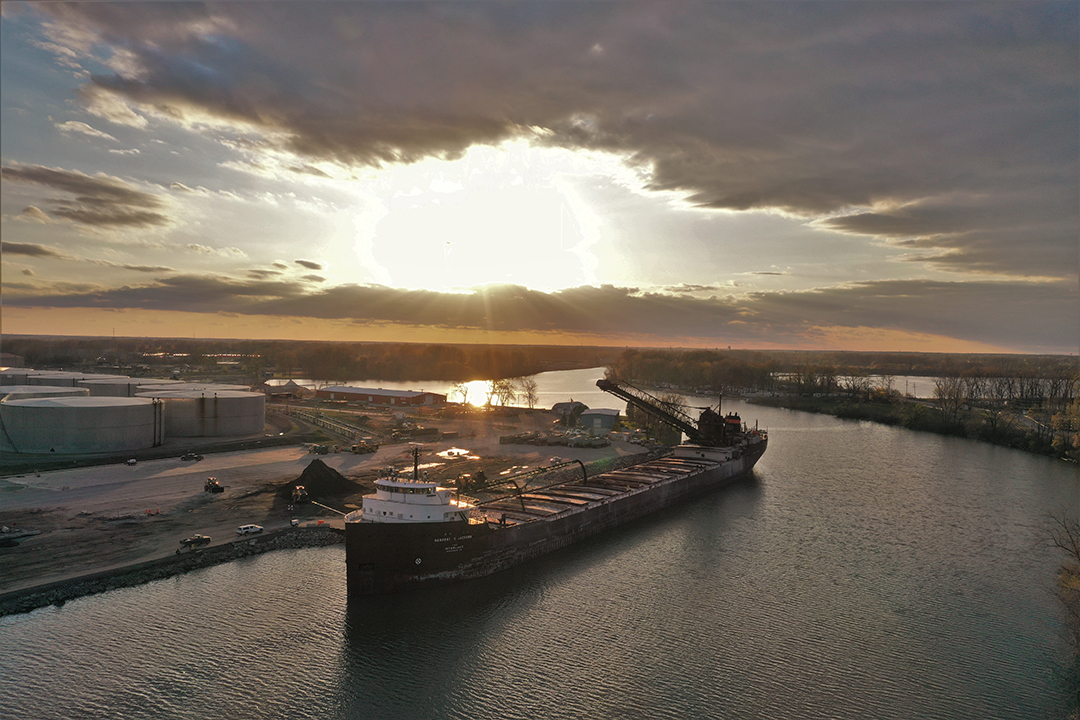
Accolades for the Biggest Little Port
The Great Lakes St. Lawrence Seaway Development Corporation (GLS), an agency of the U.S. Department of Transportation, recently awarded the Port of Monroe a 2020 navigation season Robert J. Lewis Pacesetter Award, which recognizes their efforts in increasing international Seaway cargo during the 2020 navigation season. The Port of Monroe received the Pacesetter Award six times out of the last eight seasons beginning in 2012, with consecutive awards in 2018, 2019 and 2020.
“The 2020 Pacesetter Award is truly a testament to the Port of Monroe’s resilience. We’re exceptionally proud to receive the Pacesetter Award because it is symbolic of the work ethic and professionalism of the men and women that support the biggest little port. It is also a testament to the hard work and resilience of everyone at the Port, I’m proud of them, especially after persevering through the past 18 months of the global coronavirus pandemic.” said Paul C. LaMarre III, director of the Port of Monroe
“Congratulations to the Port of Monroe for its third consecutive Pacesetter Award,” said GLS Deputy Administrator Craig H. Middlebrook. “The sustained level of high performance at the Port has positive economic implications for the City of Monroe, State of Michigan and maritime community across the system.” The Port of Monroe was one of only eight ports to receive the Pacesetter Award for the 2020 season.
From the 2018 Pacesetter Award Ceremony - Pictured Left to Right: Paul C. LaMarre III, Director, Port of Monroe; Dr. Arthur Sulzer, Founder, Maritime Academy Charter High School of Philadelphia & Advisory Board Member, Saint Lawrence Seaway Development Corporation; Craig H. Middlebrook, Deputy Administrator, Saint Lawrence Seaway Development Corporation.
As a testament to the Port’s continued success, the Port of Monroe is featured on the covers of two celebrated maritime publications, Know Your Ships 2021 and Greenwood’s Guide to Great Lakes Shipping 2021, as well as the cover of American Association of Port Authorities (AAPA) 2021 Seaports of the Americas Directory.
Established in 1992, the SLSDC Pacesetter Award recognizes U.S. ports who have registered increases in international cargo tonnage shipped through their ports and through the St. Lawrence Seaway.
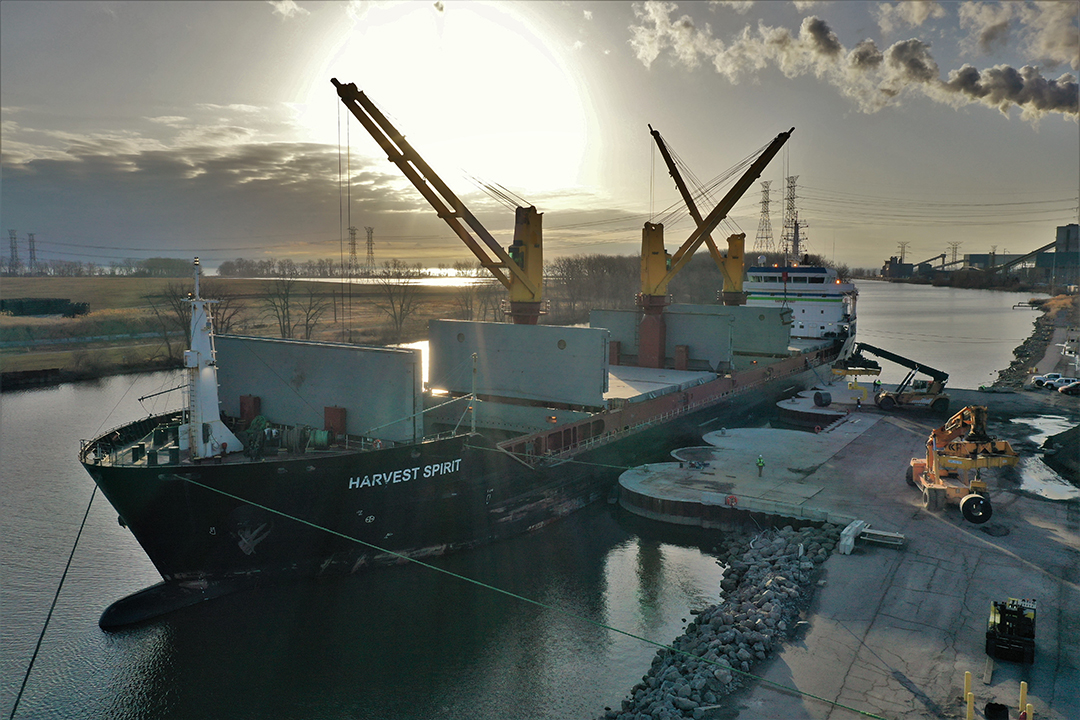
Cargo Moves
With consecutive Pacesetter awards in 2018, 2019 and 2020, the Port of Monroe is moving in the right direction. Milestones include:
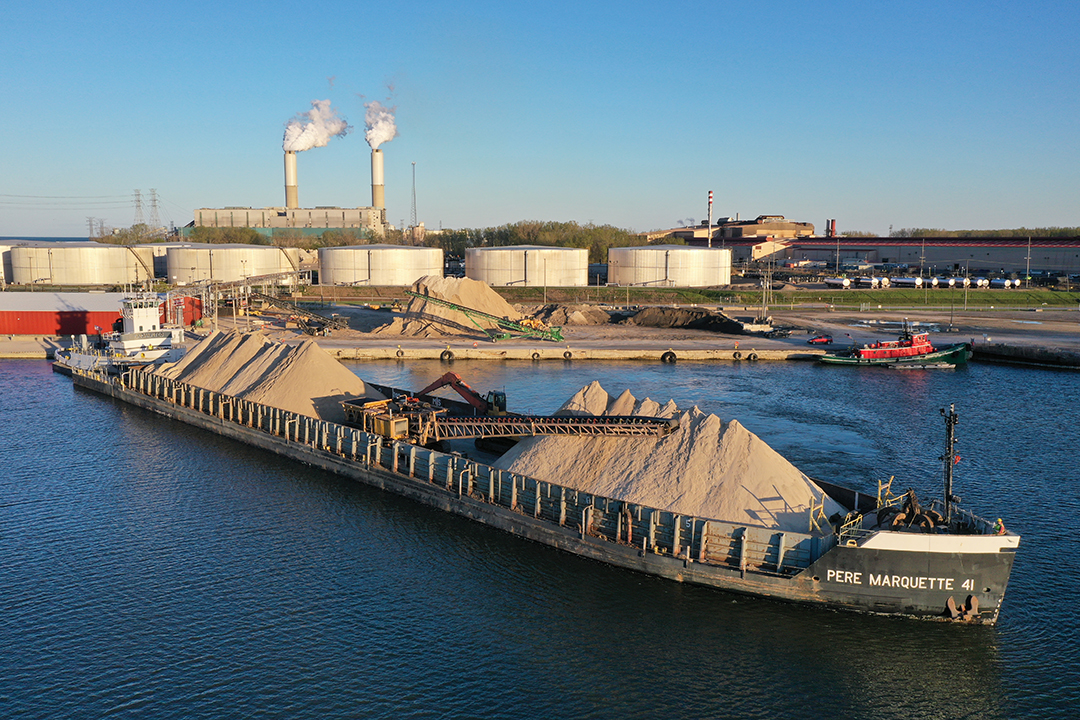
2018: Building Better Infrastructure
The 2018 season saw the first use of Port of Monroe’s new state funded Riverfront dock, which handled the first load of steel coils to Monroe and welcomed the liquid asphalt tanker IVER BRIGHT on her maiden voyage into the Great Lakes, carrying over 4,000 metric tons of liquid asphalt for Suncor.
2019: Moving the Largest International Shipment in the History of the Great Lakes-St. Lawrence Seaway System
The Port of Monroe’s noteworthy international inbound and outbound cargo handlings during the 2019 navigation season were crowned by a historic shipment. In October 2019, the Port of Monroe handled a generator stator for the Fermi II Nuclear Power Plant, which was the single most valuable piece of project cargo to ever move through the Seaway system. The Port also handled the original stator for the Fermi plant in 1976.
2020: Growing the Wind Energy Industry in America’s Heartland
In 2020, the port teamed up with Spliethoff Group’s BigLift Shipping and port tenant Ventower Industries to move, handle, and manufacture wind tower components for a large General Electric project. The heavy-lift vessel HAPPY RIVER was on a dedicated run between Monroe and Becancour, Quebec for most of the season delivering wind tower sections.
“2020 was one of the most prosperous navigation seasons in the port’s history,” said LaMarre. “That wasn’t the story that spanned the entire system, but one thing is for sure is that the Great Lakes-St. Lawrence Seaway system is resilient. Now we are in a position to increase shipments in 2021. The Port of Monroe handled around 1.4 million metric tons in 2020. With the momentum from 2020, activity at the port continued through the winter into 2021, and as the world opens up from the pandemic, we expect to surpass tonnage year-over-year in 2021.” said LaMarre.
2020: Cargo Diversification

2020: Top Performing Cargo
| Commodity | Tonnage (SHORT tons) |
| Coal & Petcoke | 938,229 |
| Limestone | 344,562 |
| Liquid Asphalt | 137,421 |
| Vessel/Bulk Product | 64,386 |
| Project Cargo | 43,404 |
About the Great Lakes Seaway Partnership
The Great Lakes Seaway Partnership is a coalition of leading US and Canadian maritime organizations working to enhance public understanding of the benefits of commercial shipping in the Great Lakes Seaway region of North America. The organization manages an education-focused communications program, sponsors research and works closely with media, policy makers, community groups, allied industries, environmental stakeholders and the general public to highlight the positive attributes of marine transportation.
The Great Lakes-St. Lawrence Seaway System is a marine highway that extends 2,300 miles from the Atlantic Ocean to the Great Lakes. Approximately 143.5 million metric tons of cargo is moved across the System on an annual basis, supporting more than 237,868 jobs and $35 billion in economic activity.
For more information, please visit http://www.greatlakesseaway.org.
###
Great Lakes Ports Work On Building Cargo Diversity
Source: American Journal of Transportation
Project cargo’s growing diversification role
Throughout the vast Great Lakes-St. Lawrence Seaway system in the United States and Canada, most ports seek to diversify their customer base by developing new business beyond traditional bulk markets. Front and center in their efforts are project cargoes, especially wind energy components destined to meet the rising demands of utilities. On the horizon, too, is a project in Ohio that could soon become the first offshore wind facility in the Great Lakes.
Wind Energy Powers Diversification
At the Port of Duluth, the top tonnage port on the Great Lakes (32 million metric tons), the Clure Public Marine Terminal handles high-value general cargo as well as project and dimensional cargoes.
Deb DeLuca, port director of the Duluth Seaway Port Authority, recently stated that “cargo diversity is important to any port and its catchment area. A mix of cargo spells economic stability.”
The port on Lake Superior along the border of Minnesota and Wisconsin has strong expectations for 2020 after shattering a wind energy cargo record last year. In total, Duluth welcomed 306,000 tons of wind energy cargo in 2019. This eclipsed the previous summit of 302,000 tons in 2008. Duluth Cargo Connect managed the unloading, storage and dispatch of the cargo to various sites in the Midwest.
Such a banner performance was termed “no accident” by DeLuca. “We’ve made more than $25 million in strategic investments to the terminal in the past four years, enhancements that help support the excellent work Duluth Cargo Connect does in handling these oversize wind cargoes.”
Indeed, the tower sections are long, but the blades are even longer – with some well past 200 feet.
“Wind energy has been an important part of our cargo portfolio, dating back to our first shipments more than a decade ago,” noted Jonathan Lamb, president of Duluth Cargo Connect. “As the farthest inland port in North America, we’re geographically well situated to support wind farm installations in the Upper Midwest and central Canada. We pride ourselves in providing a seamless connection between modes of transportation for our wind energy customers.”
Strapped for space and needing more laydown area, the port is adding 50,000 square feet of warehouse space and rebuilding two dock walls at a cost of $21 million, with construction planned for 2021-2023. Beyond wind components, Lamb says that Clure Terminal is targeting dimensional cargoes including transformers, reactors, pressure vessels and similar equipment serving mining, manufacturing, and oil and gas industries.
A number of U.S. Great Lakes ports are developing reputations for the efficient handling of project and heavy lift cargo. The Port of Bay City, Michigan on Lake Huron handled five wind energy cargoes in 2019. And the Port of Indiana-Burns Harbor handled one of the more unique project cargoes in 2019 when it moved two huge rubber-tired gantry cranes (RTG) from the port to the CSX Intermodal Terminals’ facility in nearby Chicago. The 68-piece cargo arrived at the Indiana port in June aboard the HC Melina and was discharged from the vessel by Federal Marine Terminal’s (FMT) shore crane for transport to the CSX Intermodal Terminals’ Bedford Park facility, which handles domestic and international freight.
Port of Indiana-Burns Harbor
Ian Hurt of the Port of Indiana-Burns Harbor, said FMT, the general cargo stevedore at the port, could perform two-crane lifts of nearly 200 metric tons, or 440,000 pounds, nearing the top of any port’s capabilities in the U.S. Great Lakes or Canada. “Intermodal transport requires all modes to work together seamlessly, and the gantry crane shipment is an example of the efficient transportation attributes and its connectivity in the Midwest,” Hirt explained.
At the Port of Monroe, Michigan’s only port on Lake Erie, coal remains the top commodity, but Port Director Paul Lamarre III has been a strong proponent of cargo diversity. And this strategy’s success is borne out by growing imports of project cargo and exports of wind tower sections manufactured at the port. More than a dozen BigLift vessels carrying wind components are expected in 2020.
Project cargo and heavy machinery are also handled at such ports as Detroit, Toledo and, of course, Cleveland where the Cleveland-Europe Express service operated by Spliethoff has concluded its sixth season hauling containers and breakbulk cargo between Cleveland and Antwerp.
David Gutheil, chief commercial officer of the Port of Cleveland, told the American Journal of Transportation that the port handles a significant amount of non-containerized steel, heavy lift, heavy machinery and capital equipment. Customers include General Electric, Siemens and Alcoa. He welcomed the contribution of Logistec, which has completed its first year as the general cargo terminal operator.
Proposed Offshore Wind Project on Lake Erie
Looking several years down the road, Gutheil evoked the big potential for the Port of Cleveland of a proposed offshore wind project on the shores of Lake Erie that would constitute the first freshwater wind farm in North America. Known as Icebreaker Wind, the $126 million pilot project consists of six 3.45MW turbines located 8 miles north of Cleveland. LEEDCo, a non-profit PPP, is co-developing the project with Norwegian equity investor Fred Olsen Renewables. Cleveland Public Power has committed to buying 63% of output over 16 years.
The project has won federal approval and has encountered no major public opposition (a good measure of public support, in fact). Assuming the Ohio Power Siting Board gives the green light, possibly by this spring, construction could start in 2021 and commercial operation in 2022. Ultimately, analysts suggest it could transform Ohio into a regional offshore wind-supply chain hub.
“We see much potential for us as a staging center for the energy components,” Gutheil told AJOT.
New Laydown Areas Benefit Canadian Ports
Meanwhile, officials at the U.S. and Canadian Seaway corporations are continuing to put strong emphasis on the Great Lakes/Seaway System as a non-congested and strategically-located alternative to gateways on the U.S. East Coast and Gulf for project and heavy lift cargoes.
Among Canadian ports on the Great Lakes, the newly-merged Lake Ontario ports of Hamilton and Oshawa (now called the Hamilton Oshawa Port Authority, or HOPA) are continuing to develop project cargo and breakbulk business.
On the tip of Lake Superior, the investments by the Port of Thunder Bay (mainly a grain export gateway) on a new laydown area, railway yard as well as a new warehouse scheduled for completion this May are paying off with two large wind turbine projects in Western Canada slated to use the port’s Keefer Terminal for oversized cargo.
We are also handling more structural steel and railway track for Western Canada as a result of our new laydown area,” indicated Tim Heney, chief executive of the Thunder Bay Port Authority.
Another Canadian port focused on bulk shipping that has significantly diversified its customer base due to investments in bigger laydown areas is Johnstown in eastern Ontario. Last year, it welcomed 13 multi-purpose vessels carrying 29 full sets of turbines for a regional wind farm. The laydown areas have likewise accommodated steel construction beams, and steel pipes will start later this year.
Historic International Shipments Earn Port of Monroe 2019 Pacesetter Award
The Great Lakes Seaway Partnership applauds the Port of Monroe for earning a 2019 navigation season Robert J. Lewis Pacesetter Award, which recognizes their efforts in increasing international Seaway cargo during the 2019 navigation season. The Port of Monroe received the Pacesetter Award five times out of the last seven seasons beginning in 2012.
“Above all else, it is important to the Port of Monroe and myself to be a leader and contributor in the broader Great Lakes-St. Lawrence Seaway System. We are proud to receive the award, but we’re also proud of the other Great Lakes ports receiving the award because we will succeed or fail as a system,” said Paul C. LaMarre III, director of the Port of Monroe. “The 2019 Pacesetter Award is truly a testament to the Port of Monroe’s resilience. We’re exceptionally proud to receive the Pacesetter Award because it is symbolic of the work ethic and professionalism of the people who breathe life into this place.”

"If you build the relationship, the cargo will come”
The Port of Monroe’s noteworthy international inbound and outbound cargo handlings during the 2019 navigation season were crowned by a historic shipment. In October 2019, the Port of Monroe handled a generator stator, which is the single most valuable piece of project cargo that ever moved through the Seaway system.

For almost two years, the Port of Monroe worked hand in hand with General Electric and DTE to plan the move and construct a new on-dock, heavy lift rail spur before the M/V Happy Ranger delivered the stator from Rotterdam, Netherlands to Monroe, Michigan. That very same ship was then loaded with 42 wind tower segments manufactured at Ventower, a wind energy manufacturing company based in Monroe, and shipped to Peru, exemplifying what can only be described as “logistics perfection.”

For LaMarre, the movement of the component represents the Port of Monroe coming full circle, paying homage to the Port’s movement of similar cargoes in the late 1970s. "It was a win on all levels. It achieved an investment in port infrastructure, the development of new and valuable cargo through the Seaway and benefited the community that we call home," said LaMarre.
In addition to the Seaway-wide historic shipment, the Port of Monroe also celebrated their own momentous achievement. For the first time ever, three vessels unloaded at the same time on three separate docks. The “Queen of the Lakes”, the M/V PAUL R. TREGURTHA, unloaded at DTE’s Monroe Powerplant, the M/V GAGLIARDA unloaded Egyptian salt at the Port’s Riverfront Dock, and the Barge DELAWARE and Tug CALUSA COAST unloaded liquid asphalt at the Port’s Turning Basin Dock.
Source: Great Lakes Seaway Partnership


